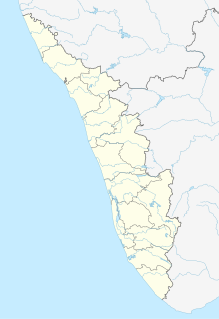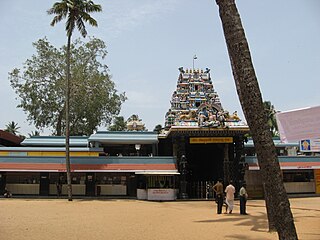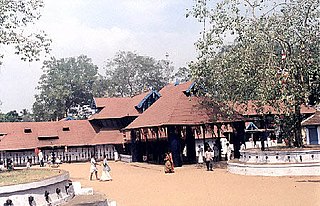Sopana Sangeetham is a form of Indian classical music that developed in the temples of Kerala in south India in the wake of the increasing popularity of Jayadeva's Gita Govinda or Ashtapadis.

The Chottanikkara Devi Temple is a famous temple of mother goddess Bhagavati. She is a form of Mahalakshmi. Lakshmi is believed to be residing in Chottanikkara along with the supreme deity lord Maha Vishnu. The temple is located at Chottanikkara, a southern suburb of the city of Kochi in the state of Kerala, India and is one of the most popular temples in the state. In terms of temple architecture, Chottanikkara temple stands out to be an ultimate testimonial for the ancient vishwakarma sthapathis along with Sabarimala temple. Sree Mahamaya Bhagavati, the goddess of saraswati, Lakshmi and Parvati is one of the most popular deities in Kerala and the supreme mother goddess in Hinduism. Chottanikkara Devi is worshipped at the temple, in three different forms: as Mahasaraswati in the morning, draped in white; Mahalakshmi at noon, draped in crimson; and as Mahakali in the evening, decked in blue. Goddess 'Keezhkkaavu bhagavathi' is believed to be Bhadrakali, in her fierce form or Ugra form. Bhadrakali, is a form of mother Kali, supposed to be born from the third eye of lord Shiva, to kill the demon king Darika. People suffering from mental illnesses and commonly visit the temple, as Chottanikkara devi is said to cure her devotees. Guruthi pooja is a ritual done at late evening to invoke goddess Mahakali. Earlier 'Guruthi Pooja' was done only on Fridays. But nowadays, it is performed every day.

Bhadrakālī is a Hindu goddess popular in Southern India. She is one of the fierce forms of the Great Goddess Shakti or Adi Parashakti mentioned in the Devi Mahatmyam. Bhadrakali is a popular form of the Great Goddess, worshipped in Kerala as Bhadrakali, Mahakali, Chamunda and Kariam Kali Murti. In Kerala she is seen as the auspicious and fortunate form of Mahakali who protects the good.

Alathiyur Hanuman Temple is a famous Hindu temple located at Alathiyur near Tirur, Malappuram district, Kerala state, India. Over the years the "custodians" of the temple were Alathiyur Grama Namboodiri, the Raja of the Kingdom of Tanur (Vettathunad), and Samoothiri of Kozhikode. According to local myths, the "Purumthrikkovil idol" of the deity Hanuman was consecrated 3000 years ago by Vasistha, one of the Saptarishis. Even though the main deity of the temple is Hindu god Rama the temple is famous and known as a "Hanuman temple". The shrine of Hanuman is located to the south of Rama temple, and there are sub-shrines for Ganapathi, Ayyappan, Durga, Bhadrakali and Lakshamana in the temple.

Mudiyettu is a traditional ritual theatre and folk dance drama from Kerala that enacts the mythological tale of a battle between the goddess Kali and the demon Darika. The ritual is a part of the bhagavathi or bhadrakali cult. The dance is performed in bhadrakali temples, the temples of the Mother Goddess, between February and May after the harvesting season.

Sarkaradevi Temple is one of the most important temples in South India. It is situated South of the Chirayinkeezhu Taluk . The nearest town is Attingal and Varkala. Tradition accords a remote antiquity to this temple. Its main deity is Bhadrakali. The Sarkaradevi Temple assumed a significant status for many reasons and rose to historical importance mainly with the introduction of the famous Kaliyoot festival by Anizham Thirunal Marthanda Varma, the Travancore sovereign, in 1748. The Sarkaradevi Temple have some basic attachment with Nakramcode Devi Temple which located in Avanavanchery,Attingal.

Valliyoorkkavu is an ancient Bhagavathy temple located near Mananthavady in Wayanad district. The temple is for Goddess Durga as its presiding deity in three forms namely: Vana Durga, Bhadrakali, and Jala Durga.

Thiruvambadi Sri Krishna Temple is a Hindu temple in the city of Thrissur in Kerala, India. The main deities of this temple are Lord Krishna in the form of a child, and Goddess Bhadrakali, both having equal importance. There are sub-shrines for Lord Ganesha, Lord Sastha and Brahmarakshas, and there is a sub-temple for Lord Ganesha behind the temple. The temple is one of the two rival groups participating in the Thrissur Pooram, which is the biggest local festival in Kerala. Bhagavad Gita chanting makes the temple alive. Every day the Devaswom gives free lunch to people.

The Attukal Bhagavathy Temple is a Hindu religious shrine at Attukal in Kerala, India. Goddess Bhadrakali (Kannaki), mounted over 'vethala', is the main deity in this temple. Bhadrakali, a form of Mahakali, who killed the demon king Daruka, believed to be born from the third eye of lord Shiva. 'Bhadra' means good and 'Kali' means goddess of time. So Bhadrakali is considered as the goddess of prosperity and salvation. Goddess 'Attukal devi', itself is the supreme mother 'Bhaadrkali devi', the goddess of power and courage. She is often referred as Kannaki, the heroine of Ilanko Adikal's 'Silapathikaaram'. The temple is renowned for the annual Attukal Pongal festival, in which over three million women participate. A festival that has figured in the Guinness Book of World Records for being the single largest gathering of women for a religious activity, the Attukal Pongala continues to draw millions of women with each passing year. According to the Attukal Temple Trust, around 4.5 million devotees are expected to attend the pongala in 2016. Attukal Temple is situated near the heart of the city, 2 kilometres away from Sree Padmanabhaswamy Temple, East Fort in Thiruvananthapuram. Devotees believe that all of their wishes will be fulfilled by the goddess, provide prosperity and can attain salvation. Attukal devi is often worshipped in 3 forms such as Maha Saraswati, Maha Lakshmi and Mahakali/ Durga/ Parvathy.
Eravikulangara Bhagavathy Temple is an ancient Hindu temple in the Ernakulam district of Kerala, India, dedicated to Bhagavan Sivan and Bhagavan Ayyappan.

Thiruvarkadu Bhagavathi Temple is the mother temple of all Bhadrakali shrines of North Kerala. The deity is the Fierce form of Bhadrakali. The Bhagavathy is addressed by tantrics in the vicinity as Tiruvarkkad Achchi due to this. The temple administration is Malabar Devaswom Board. The temple is a revered shrine of Chirakkal Royal Family and a shrine of Chirakkal devaswom before. The temple is situated in Madayi, Payangadi, hence prominently known as Madayi Kavu.

Kummattikali or Kummatti Kali is the famous colorful mask-dance of Kerala, prevalent in Thrissur District, Palakkad District and parts of South Malabar. During the festival of Onam, Kummattikali performers move from house to house collecting small gifts and entertaining people. Kummatti dances are rampant in the Thrissur district during Onam. Pristine or original form of Kummattikali can be seen in the Bhadrakali temple in Palakkad district. Kerala

Theeyaattam also known as Theeyaattu (Tīyāttu) is a traditional dance form. There were two types of Theeyaattam – Bhadrakali Theeyaattu and Ayyappan Theeyaattu. Bhadrakali Theeyattu is performed by Theeyaattunnis whereas Ayyappan Theeyaattu is performed by Tīyyādi Nambiars (Ambalavasi).

Sree Kurumba Bhagavati Temple is a Hindu temple at Kodungallur, Thrissur District, Kerala state, India. It is dedicated to the goddess Bhadrakali, a form of Maha Kali or Parashakthi worshipped in Kerala. The goddess is known also by the names "Sri Kurumba"" .This temple is the head of 64 Bhadrakali temples in Kerala especially Malabar. The goddess of the temple represents the goddess in her fierce ('ugra') form, facing North, featuring eight hands with various attributes. One is holding the head of the demon king Daruka, another a sickle-shaped sword, next an anklet, another a bell, among others. Routine worship at the temple every day at 03:00 and ends at 21:00 local time.

Tholpavakoothu is a form of shadow puppetry that is practiced in Kerala, India. It is performed using leather puppets as a ritual dedicated to Bhadrakali and is performed in Devi temples in specially built theatres called koothumadams. This art form is especially popular in the Palakkad, Thrissur and Malappuram districts of Kerala.

Padayani, also known Padeni, is a traditional folk dance and a ritual art from the central portion of the Indian state of Kerala. A ceremonial dance involving masks, it is an ancient ritual performed in Bhagavati temples. The dance is performed in honor of Bhadrakaali. Meaning, a 'row of warriors', Padayani is an art form that blends music, dance, theatre, satire, facial masks, and paintings. It is part of worship of Bhadrakali and is staged in temples dedicated to the goddess from mid-December to mid-May. Padayani is unique to central Travancore, comprising the Pathanamthitta and kottayam districts of Kerala. Padayani is regarded as a remnant of the Dravidian forms of worship that existed before the advent of Brahmanism.

The Vellayani Devi is a highly revered shrine in Kerala, India, dedicated to goddess Bhadrakali. The shrine is situated in Vellayani 1.5 km west of Vellayani junction, 12 km southeast of Thiruvananthapuram on the eastern bank of Vellayani Lake. The temple is under the management of Travancore Devaswom Board. The temple structure has a bronze roof with traditional art work and carries Dravidian architecture. The temple has eastern and northern towers called Gopurams with statues of different Gods sculptured in them. The Gopurams function as gateways through the walls that surround the temple complex.
Pathiyanadu Sree Bhadrakali Temple is one of Hindu goddess Bhadrakali temple in Kerala. The shrine is in Mullassery. It is 1.5 kilometres from Karakulam under Nedumangad Thaluk. It is 12.5 kilometres from Thiruvananthapuram. The temple is managed by Pathiyanadu Sree Bhadrakali Kshetram Trust.

Pattupurackal Bhagavathy Temple is an ancient Bhadrakali temple located in Njeezhoor village, Kottayam. It is the only temple in Njeezhoor village where presiding deity as Sree Bhadrakali. Offering naranga vilakku and neivilakku on every Tuesday and Friday is very significant in this temple. The nearest towns are Kuravilangad and Kaduthuruthy. It is about 6 km and 11 km away from temple respectively. The last renovation activities were done on 19 March 2016 with the presence of Kshetra Thantri Brahma Sree Anil Dhivakaran Namboothiri. The temple is managed by NSS Karayaogam Number 336.
This is a list of ancient Buddhist sites, relics, traditions and places from the Indian state of Kerala. Even though Kerala does not have any major presence of Buddhists in modern times, many historians recognize a Buddhist heritage that seem to have existed until the 10th century CE along with a widespread Sramana tradition of co-existence between Vedic Hinduism, Buddhism, Jainism and ancient Dravidian folk religion.
















